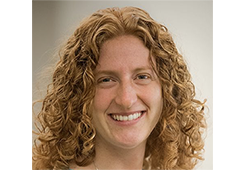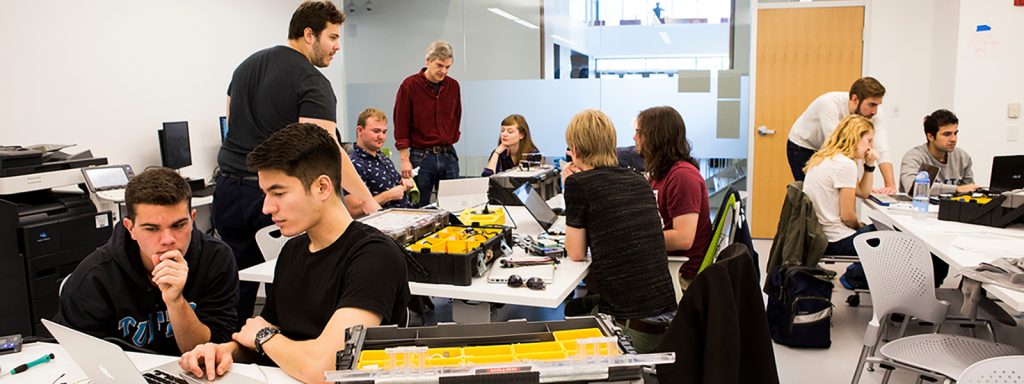
Beyond the Lecture: Rapid-fire Faculty Development Event for SOE faculty
Interview with Dr. Erica Kemmerling of Mechanical Engineering, by Alicia Russell of Tufts Center for the Enhancement of Learning and Teaching
How quickly could you explain a new learning experience you had developed for your students?
At “Beyond the Lecture,” a recent faculty development event for School of Engineering faculty, five professors had a chance to find out. The event, which was run “Speed Dating style,” was developed by the Center for the Enhancement of Learning and Teaching (CELT) in collaboration with the Tufts Center for Engineering Education and Outreach (CEEO). Participating faculty members were challenged to explain their innovative instructional experience in just ten minutes while visitors moved from one table to the next. Each presenters’ passion for improving teaching and instruction was obvious to their listeners who heard about learning experiences such as “Get off the campus (GOTC), “The Lab’s the Thing,” “In the News,” “Developing Whole Engineers,” and “Active Activities.” The only disappointment was in not having time to hear from each one!
Dr. Erica Kemmerling was one of the faculty members who participated. Below she describes the instructional experience she calls “Personal Problems” in her Mechanical Engineering (ME 16) Heat Transfer course.

T@T: Please describe the instructional experience you developed.
Kemmerling: I’ve implemented personalized problems in ME16, a junior-level undergraduate course required for mechanical engineering majors which has been historically unpopular. I recently received a Tufts Innovates grant to expand the program to two other undergraduate courses, both in the thermofluids division of mechanical engineering.
“What preparation is needed?” (for the instructor, for students)
The preparation on the instructor side is somewhat extensive but can be front-loaded. The instructor must survey students on their hobbies, interests, and backgrounds unrelated to the course material. The instructor then needs to write an open-ended problem that applies concepts from the class to each student’s personal interests. The biggest time commitment comes in thinking up ideas for the problems (and reading about random things on Wikipedia.) Some students may even request specific concepts for their own problems, which makes the instructor’s job much easier. The instructor can write a problem that puts the burden of looking up numbers on the students so he or she doesn’t have to do any calculations on their own. Here’s one example problem I wrote for a student who said she liked baking:
As a publicity stunt, Tony Monaco has hired you to bake a single cake that will feed the entire Tufts undergrad population. He is willing to pay for a custom oven to do this. Design your cake and oven and specify a protocol for baking it such that the middle will get done without the edges getting dry or burnt. Back up your design with heat transfer analysis.
One note about course prep time: once you do it once, the course should be much easier the second time around because you can reuse problems. The new class won’t be a 100% match to the old class’s interests, but there are some interests that will come up in every class: swimming, running, skiing, cars, planes, and many others are very common for mechanical engineers.
“What skills are necessary?” (for the instructor; for the students)
No additional skills are necessary on top of what is already taught in the class (and the instructor’s creativity.) This is the main goal of personalized problems: to make students comfortable and interested by getting them to think about the class topic in the context of things they already know and enjoy.
“What resources are required?”
The main resource that must be allocated for this technique is time. Personally, I chose to have the students work on their problems in class, and spread out the problems over five sessions during the semester. This means I had five fewer lectures to work with, so I covered less material than I would have in a pure lecture course. However, this is customizable, and an instructor could also choose to assign the personalized problems as homework.
“How much class-time does this take?” “How often does this happen?”
As I mentioned above, I chose to use five class sessions spread out over the semester (approximately once every two weeks.) However, the technique is flexible and could be implemented on a different schedule.
“How do you balance content delivery with including this technique?”
This was not easy and will probably vary from course to course. Personally, I took the original syllabus and ranked every topic on it as (1) critical, (2) important, or (3) luxury. Basically, all of the luxury lectures got cut in favor of reinforcing the critical and important material. It is noteworthy that I was more aggressive in cutting applied heat transfer topics than basic science topics, as the personalized problems were ALL applications.
“What can go wrong? What do you do to salvage/recover/etc?”
Not much can go wrong if you prepare well. As always, some groups do a better job than others, but we had a zero failure rate. One challenge is that it’s difficult to grade open-ended problems, so the instructor should come up with a very specific rubric regarding what he/she is expecting. I had the students give five-minute presentations on their work at the end of each session and graded the presentations. In retrospect, I don’t think the students learned much from each other and next time I might prefer that they turn in written work.
What are the next steps for this course?
ME16 is being discontinued, so I am adapting the personalized problem program for its replacement courses, ME50 and ME51. I hope to eventually expand the personalized problems program to non-thermofluids courses as well.
Anything else you’d like to add?
The students really liked the personalized problems. I got comments that they felt like I cared about them as people and that seeing relevant applications made them more interested in the course. One underrepresented minority student told me I was one of the few professors whom he felt really met him on his level.


